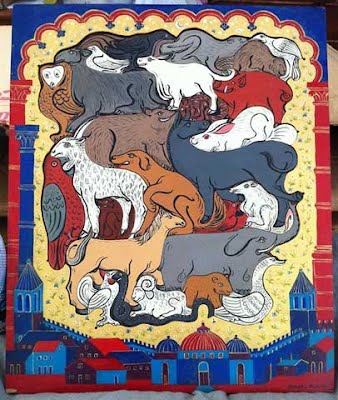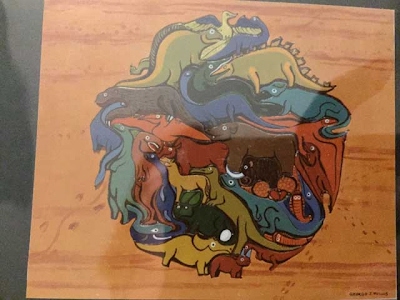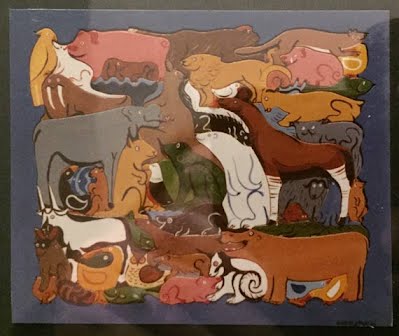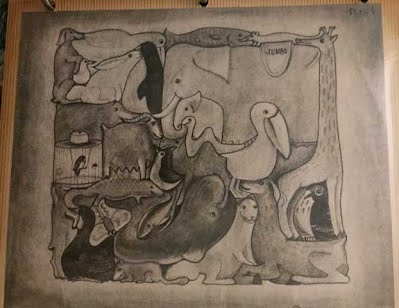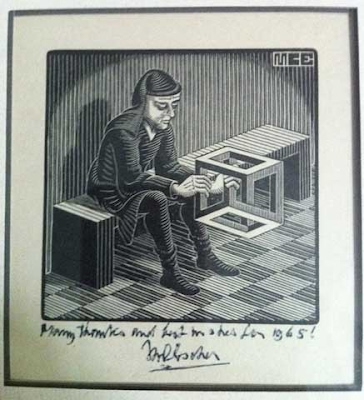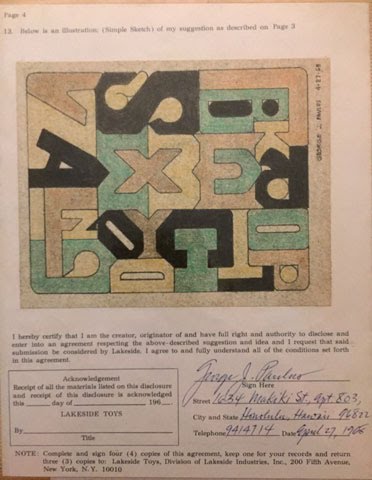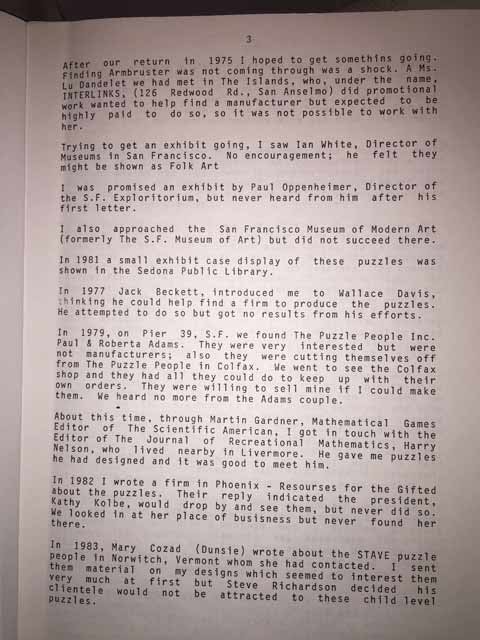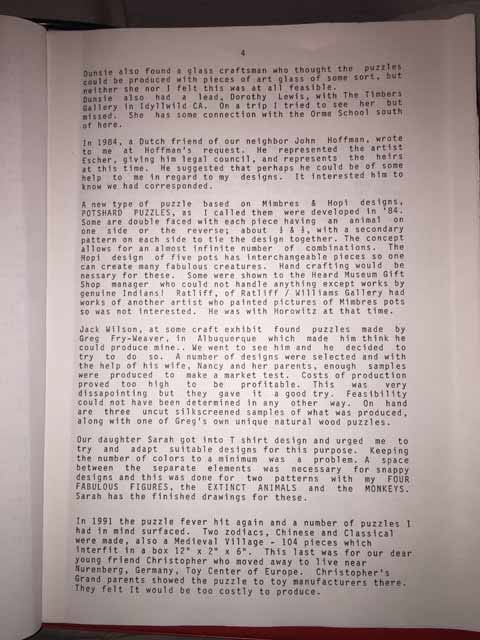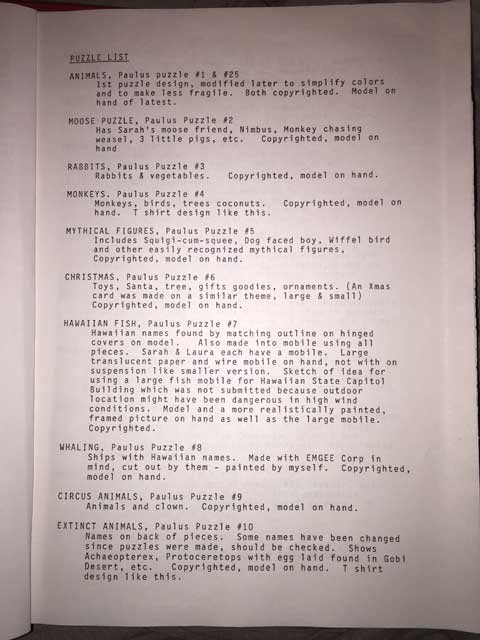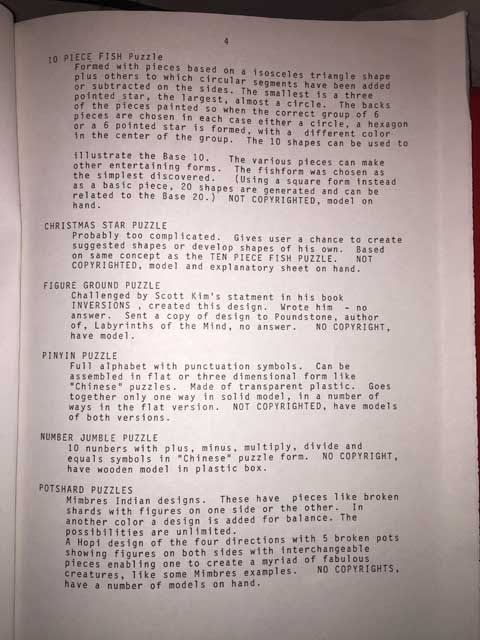George Jackson Paulus (8 July 1910–20 December 1995), an architect from California, USA, can be described as a major figure in cluster puzzle history (although of course not known by the title of the day), with numerous, high-quality themed instances, such as circus animals, dinosaurs and Noah’s Ark, of the higher principles of tessellation, of no gaps or overlaps. Paulus shows no less than 25 instances as artworks and puzzles, from 1947–1991, an impressive high figure, with the condition of high quality, with themes invariably prevalent. Broadly speaking, each motif is portrayed in the manner of Escher, with interior detail simplified, not rendered photorealistically, nor minimised. The Escher-style presentation, to me at least, is favoured, as I discuss elsewhere. Like much of the early practitioners, he worked in isolation, essentially unaware of preceding examples, with his work unknown, save for the immediate family. Paulus’s work in the field essentially came to notice in 1990, upon the publication of the first edition of Visions of Symmetry by Doris Schattschneider, p. 306, where he is briefly mentioned, essentially in passing, in Schattschneider’s ‘Notes on the Drawings’. Specifically, this concerns Escher’s drawing No. 83, ‘Thirty-Six Different Motifs’, which served as the model for Plane Filling I. Schattschneider gives: ...In 1963, an American architect, George Paulus, sent Escher examples of different interlocking animal shapes he had devised (one was patented in 1947 as a puzzle). Escher acknowledged them, “You are the first who shares my (secondary) hobby for irregular fillings” and enclosed a print of his mezzotint. Although not stated as such, this was found, along with correspondence between Martin Gardner and Paulus upon her research visit to the Haag Gemeentemuseum in 1976, where she made copies. However, I use ‘come to notice’ figuratively here. More exactly, the work was at least established in print, but so far as I am aware, not mentioned by others since!
All photos are copyright Laura Kutney. An inventory, based on the ‘Puzzle List’. Numbers in brackets are as listed in Paulus’s inventory. Artworks Overall, there is much here to be impressed about. Such a relative abundance of works, and number of pieces thereof, all of good quality artwork, of a challenging specific nature, of a variety of animal themes, is thus indicative of excellence all round, which is indeed the case here. Picking a ‘best’ is an invidious choice; they are all of a high standard. However, if pressed, I would select Extinct Animals. Others, notwithstanding the intrinsic quality, by sheer number alone are also impressive, such Noah's Ark. Overall, I am most impressed with these; a challenging type (themes), with overwhelmingly good articulations and relatively high number of pieces, not to mention the innovation of their own devising.
Animals, left, Christmas, right Themes A special mention should be made of the theme idea. Although unstated as such as to why this was invariably used time and again, this appears to have been a condition of Paulus. Almost certainly here, this was for the sake of an inherently more cohesive puzzle. All animals, Christmas, Extinct Animals, Halloween, Greek Gods, Noah’s Ark, Rabbits are not coincidental! As I have discussed in detail on the generic page, this is of added value, as against a more arbitrary assembly of animals, or objects that do not have any unifying aspect. Further, there is mostly an aim of having the motifs in a sensible orientation, rather than appearing at all angles, although again, there is nothing wrong with this, as discussed on the generic page. It’s just simply that the conditions of Paulus, of themes and sensible orientations are of a higher degree of tariff, if you like, and so are thus more praiseworthy than such other instances. Major Events, by Year 1960, Martin Gardner Connection and Interaction (1) Of interest is his Martin Gardner connection and interaction. This dates from July 1960, when he sees ‘Incidental information about the extraordinary number pi’ article in Martin Gardner’s column in Scientific American and begins correspondence with Gardner. He also correspond again, December 1975, with a handwritten letter to Martin Gardner, see under that year. 1963, Escher Connection and Interaction - Letter to Escher Of considerable interest is his Escher connection and interaction, upon having noticed Escher’s own interest in the genre of Plane Filling I and Plane Filling II, which began when he sent be a letter, dated 20 March 1963 and what appears to a single picture of his own work to Escher for comment, below.
The original of which Paulus sent to Escher. Of interest is that this is his first work, of 1949, as referenced in his letter. 1964, Escher Connection and Interaction - Letter from Escher Escher wrote back a year later, 29 March 1964 (see notes, [1]). As alluded to above, this is documented briefly in Doris Schattschneider’s defining work on Escher, Visions of Symmetry, p. 306 in a discussion on periodic drawing 83, used for the print Plane Filling I. Here she quotes a brief passage of the initial response from Escher (the whole letter, which I have seen, is in the Geemtenenmuseum archives). ‘You are the first who shares my (secondary) hobby for irregular fillings’ He also sent Paulus the print Plane Filling I. All this is illuminating in many ways. It is clear that Escher too, as late as 1963, was wholly unfamiliar with the instances prior to this date. No mention is made of Schoonderbeek patent, which is strange, in itself, as well as being a Dutch connection, an obvious point of interest. Further, Paulus states: …About a dozen more, using fabulous beasts, extinct animals, living animals, Christmas symbols etc… One may perhaps have thought that Escher may have taken more interest in this. Escher was plagued by ill health in the 1960s, but there is no indication that this coincided with this; 1963 was a productive year. 1965, Christmas Greeting 1967-1969, Lakeside Toys Interest Between the years 1967-1969, Lakeside Toys, a relatively big name of the day, showed interest in an alphabet puzzle, of which matters progressed to a signed stage between the parties pending commercialisation. However, this never materialised. Paulus related in Puzzle List p. 2: One company, Lakeside, showed interest during ‘67-‘69 but nothing came of this although I made a special design for them… Cutting off Lakeside, who had done nothing they had promised... Frustration personified! On Lakeside Toys, little is known. They are barely discussed on the internet, despite seemingly being a relatively big name of the day. In short, from what little detail there is, they can be described as a children's toy, games and puzzle company. They flourished in the 1960s, before being sold to Leisure Dynamics in 1969. What is interesting is that around the same time of the Paulus interaction they produced six themed cluster puzzles. However, despite a plausible link, there is no known connection here with them and Paulus. Possibly their interest in Paulus's work fizzled out with the sale of the business.
Lakeside Toys Agreement with Letters Puzzle 1968, Design Patent, ‘Alphabet Puzzle or the Like’ Paulus, in 1968, patented one of his (non-animal) alphabet letter puzzles as a ‘Design Patent’, number 212,242, titled ‘Alphabet Puzzle or the Like’. This consists of the 26 letters of the alphabet, arranged in two rows. The patent, seemingly his only one, is not particularly expansive, of just a single page. Paulus states, aside from figure captions: The dominant feature of the design is the cluster-forming characteristics of the letters. claim: The ornamental design for an alphabet puzzle or the like, substantially as shown and described. Interestingly a ‘cluster’ reference is made! Note that this is not to be confused with a reference in Schattschneider giving a patent date of 1947, of which upon discussion with her was of another puzzle by Jacobus Schoonderbeek, enclosed by Paulus to Escher which led to the mix-up. The 1968 patent is not referenced by her in any way. The patent is also referenced in his ‘Puzzle List’ as #24, as a ‘slightly improved version’. However, there is no indication that this was ever produced. 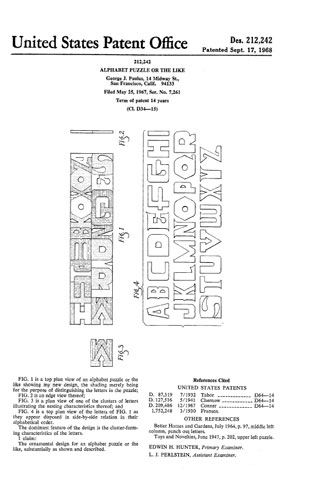 Patent 1975, Martin Gardner Connection and Interaction (2) He also correspond again with Gardner, following on from 1960, in December 1975, with a handwritten letter to Martin Gardner, see under that year. As the text is not of the greatest clarity, I show a transcript as best as I can make out: December 3 1975 Dear Mr Gardner Thought you might get a kick out of these. I wish(?) I could get a chance to show you all the designs I have developed. I did get copyrights “Class G” on most of them. Not much protection but if I get royalties between ages 65 and 72 it does not apply(?) wager(?) if protection is issued before retirement age! I’m hoping to be able to exhibit in one of the big San Francisco art museums. Art to take apart! Hold the good thought – Happy holidays c. 1991, Puzzle List and Paulus Puzzles Paulus documented his work, notably with ‘Puzzle List’, a five-page inventory listing, with brief commentary of all his 27 numbered puzzles (and others), and not just of cluster puzzles and ‘Paulus Puzzles’ a five-page essay in which he gives a detailed history, of Escher interaction and the trial and tribulations of attempts at marketing. Both are invaluable in many ways, of which without the story could not have been told. Given their importance, I show these in full below. The ‘Puzzle List’ also includes 12 puzzles not numbered, and a ‘pattern list’ (tessellation?). A feature of the ‘Paulus Puzzles’ document is the length Paulus went to promote and market his work, contacting numerous puzzle and toy companies, throughout the years, all, it has to be said, sadly without success. There are about 19 interactions listed. No matter what he did, he was thwarted at every turn! Paulus seems to be one of those unfortunates who are not the ‘chosen few’. Who knows what might have happened if he had a lucky break? His work was more than deserving. However, it won't be for the lack of effort on my part in promoting him though! Perhaps this piece may inspire renewed interest in him. Although not detailed as to why, Paulus refers to matters of copyrights in the ‘Puzzle List’, with each entry having ‘copyrighted’ or ‘not copyright’ (with minor variants as to wording). Indeed, the whole document is organised in this manner, with the works having copyright listing as a (unstated) block (#1-27), followed by non copyright. Matters of copyright are unfamiliar to me, beyond the basics, and the nuances of which I care little to investigate in-depth. And then there's patents of perhaps even more complexity… Obviously here, the intention is to protect his intellectual property rights. Paulus Puzzles, pages 1-5 Pages 1-2 Pages 3-4 Page 5 Puzzle List, Pages 1-5 Pages 1-2 Pages 3-4 Paulus and Family And what of Paulus himself, the family man, what was he like? In short, he can be described as devoted to his wife, or as he preferred, his bride, Jane (Tutu). Laura Kutney, his granddaughter, gives a heartwarming account of him and their devotion on her ‘Elephant Journal’ blog, below. To give some indication, a few passages: My grandfather was an architect by profession, but he was also an artist of just about every genre. He was a man of many hobbies, one of which was learning all about the cultures and religions of the world and he especially loved the Greeks. There were paintings and sculptures of fantastical creatures and Gods all over my grandparent’s home. He was like a sponge that couldn’t absorb enough knowledge about his beloved Greek Gods. My grandparents were great conversationalists who loved to travel, play a board or card game, entertain, joke and have fun, but mainly they loved doing all of these activities together. Their bond was so strong; one could tell by merely looking at the way they gazed at each other or were in constant physical contact, how much they cared for one another. In every photo I can find of the two of them, even when there are other people between them, they are always seen looking toward each other. And why would they ever bother to look at the camera (or anyone or anything else for that matter) when they would rather be looking toward the other half of their souls? My grandfather, George, always took a morning walk, and as predictably as the Old Faithful Geyser, he would steal a single flower for my grandmother from a different garden along his path each day—his daily gift to his beloved wife who he always introduced as, “my bride Jane.” 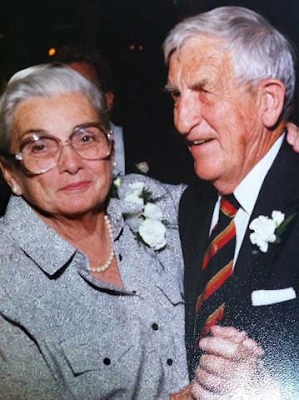 George and Jane (Tutu) Paulus References Books Schattschneider, Doris. Visions of Symmetry. Revised and expanded edition published in 1990, Abrams New York 2004, p. 306. Web Kutney, Laura. ‘The Grass is Always Greener: The Dichotomy of Relationships vs. Singledom’, 7 January 2014. ————. ‘Love Lessons from a Romantic Grandfather’, 28 March 2014. https://www.elephantjournal.com/2014/03/love-lessons-from-a-romantic-grandfather/ Sysoon (Sysoon is a website for people who love history, genealogy, cemeteries, web tools and apps). A strange site, it does nor appear possible to join or log-in! Pushed to pay at ‘Archives’ site. Gives basic born and death details. https://www.sysoon.com/deceased/george-j-paulus-237?q=george+j+paulus Geni. Free basic detail, better than most. Pushed to pay at ‘MyHeritage’ site. https://www.geni.com/people/George-Paulus/6000000010781013897 Ask Art. Very basic detail. Gives Hughes reference, below. Pushed to pay. The site states: Full access to biographies is free each Friday. Hughes, Edan Milton. Artists in California, 1786-1940. Crocker Art Museum; third edition, 2002. Nearly 20,000 biographies. From a reference in ‘Ask Art’. Not seen; judged uneconomical to pursue. Personal correspondence (email) Doris Schattschneider, dated 6, 10 January; 24 October 2016. Laura Kutney, dated 23, 24, 25, 26, 29, 30 October; 1, 15, 23 November 2016; 7 February 2017. Notes [1] Given the month and year, I thought possibly that Escher had mistyped the year, but this is not so; it is indeed 1964. In the letter, Escher references a US visit, of which upon checking was indeed mooted for 1964, but due to ill-health fell through. Timeline 1910. Born in Wisconsin, on 8 July. 1941. 18 October, marriage, age 31, to Jane Gunter. 1946. Saw Escher's works displayed in the San Francisco Museum of Art. Likely his first encounter with Escher. Suitably inspired, tries some Escher-like tessellations. 1949. The first cluster puzzle, Animals. 1960. July. Sees ‘Incidental information about the extraordinary number pi’ article in Martin Gardner’s column in Scientific American and begins correspondence with Gardner. 1963. 20 March, writes a detailed letter to Escher, enclosing Animals, from 1949 and Schoonderbeek’s patent. 1964. A year later, on 29 March, Escher replies, sends Plane Filling I. Escher makes clear this is the first instance he knows of by others. 1964. Christmas. Escher sends the small print ‘Man with Cuboid’ to Paulus as a Christmas greeting. 1967–69. Initial interest from Lakeside Toys, which fizzled out. 1967. Moves to Hawaii. 1968. Design patent for ‘Alphapack’ and ‘Mathpack’. 1969. 24 April, granddaughter Laura born. 1975. Returns to San Francisco. 1975. 3 December. Letter to Martin Gardner, including cluster puzzles in the text, c. 1979. Contact (via Martin Gardner) with Harry Nelson, editor of The Journal of Recreational Mathematics. 1981. Small exhibit at Sedona Public Library, Arizona. 1983. Contact with Steve Richardson of Stave Puzzles. 1984. ‘Potshard Puzzles’, based on Mimbres and Hopi designs developed. 1995. Dies in Oceanside, California, USA. Acknowledgements Laura Kutney, for making the family archives available, and much email discussion. Doris Schattschneider, for detail of the Gemeentemuseum Escher-Paulus correspondence. Created 14 April 2020 as Release 1. Regarded complete as of * 17 April 2020. |
Cluster Puzzles >
